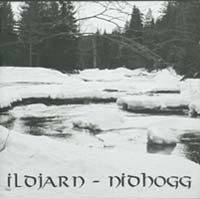Ildjarn - Ildjarn-Nidhogg
Review: The repackaging of older material has always been a difficult business, since it usually leaves a void of purpose in which the listener is left to surmise commercial motive; however, the dauntless team of Ildjarn-Nidhogg have released older material in a "framing" which unites the past of extremely rudimentary music with the future of sweeping ambient soundscapes. This is done through new songs centrally located to divide up the remaining content on this album, but these can only be discussed in the context of the signature music for which Ildjarn (and Ildjarn-Nidhogg) is known.
Popular music, including underground black metal, is composed for the most part of riffs, distinguishing it from classical music, in which melodies emerge through a series of motifs, or variations on the structure of the melody which hint at its development. Foregoing any of the more elaborate dressings given to popular music, most notoriously in progressive rock and jazz, Ildjarn distinguished itself by creating music barely distinguishable from pure noise. Three note riffs build ambience like early Tangerine Dream albums, using the simplest allure of tonal and rhythmic differential as hook, and then slowly build an atmosphere in which microscopic variations can over time redirect the entire sense and sensation of the piece toward a new direction in its evolution. Constant percussion underlies each arrangement, with vocals off the rhythmic grid screamed like an afterthought commentary, inflecting in timbre and syllabification what is unclarified by audibly indistinguishable content. The result is like morse code tone poetry, with an infectious rhythm pulling the listener into a dark world which like a snake in fire mutates into a retinue of permutations directed toward an ultimate mood, or theme, which both reinforces the literal reality of basic music making (a connection to the now: the unchanging, ultimate, all-pervasive immanence of existence) and tunes it to the fleeting fragment of emotion that motivates each piece.
The earliest works from Ildjarn, and Ildjarn-Nidhogg, the artist plus one valued collaborator, capture these micro-atmospheres with the breathless sense of unexpected insight that suggests these were concepts penned in sudden moments lost in the beauty of a forest, or in the quiet insensible seconds before sleep overcomes. They are as a result beyond any kind of manipulation except for their desire to maintain an addictive and energetic rhythm which becomes the framework for their self-alteration. From these unselfconscious works the artists moved to a style of ambient electronic music that was at first hasty, with the double-disc "Landscapes" resembling their guitar-based music slowed down and rendered through keyboards, but then grew to a studied and emotive maintenance of atmosphere with the Hardangervidda series of two volumes. On the self-titled "Ildjarn-Nidhogg" release, three tracks are added as a means of transit between blocks of older recordings. The magnificient "Existensens Jeger" opens the CD, and catches as if in a morning ray of sunlight all that was black metal when the genre was healthy: an aggressive independence, a feral naturalism of emotion, a transcendental idealism of vision, and most of all, a playful sense of creation and destruction that exceeds the bounds of mortal fear that hold most ensnared.
This track, and the mid album "Svart Dag (the Nothingness)", conduct the static ambient nature of early Ildjarn with the narrative, fully motif-driven compositional language of Ildjarn-Nidhogg atmospheric material, using a device long forgotten to most black metal musicians: the second guitar track. Much like the distorted chiaroscuro haze of Burzum's Filosofem, these tracks have one guitar track iterating the lead riff over a machinelike racing constant, unsycopated drumbeat, with additional guitars layered in the background using both noise and counterpoint melodies of a few notes' difference to accent and reinforce the dominant phrase, alternatingly. As on Darkthrone's "Transilvanian Hunger," four notes are repeated in two forms comprising complementary riffs, but here, in the background a feedback squeal melts into a guitar track playing single notes to the chords underlaying it, dropping into slightly dissonant, subtly beautiful harmonies which like the first realizations of the vastness of life in the waning years of childhood, are both full of energetic wonder and epically isolated.
Unlike any other black metal band for its tenacity in reducing music to its absolute basics without falling into monodimensional repetition, Ildjarn weaves perception and feeling together in a mixture of aggression, melancholy, heroism and humor, creating micro-pieces that show wisps of different views to a central truth, without attempting to record that truth itself; this creates the final dimension of ambience, one on an intellectual level within the receptive listener, and culminates a building pyramid of moods which brings the listener into a world both alienated and hopeful in the strength of its own action. For a compilation of works ranging over such a span of time, this compilation unites the past with the remaining breath that "black metal" has in the current time, demonstrating both that there is a path outside the droning directionlessness and that spirit is eternally resurgent where one cares to look, even in the smallest of symphonies.
